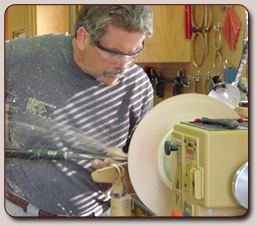Artist Statement
John S. Chianelli, Wood Turner
I have always enjoyed working with wood and have been especially attracted to the idea of turning wood. Working with pottery for 10 years I felt it would be a natural progression to this art form. I believe it is my years of pottery experience that eventually lead me into working wood as a medium in this manner. Throwing clay vessels on a potter’s wheel and turning wood on a lathe both require the medium to be spinning to take shape. While clay has to be coaxed and formed into a shape, wood forms must be extracted from a solid wood blank. I think of it as pushing clay into form versus carving a form from wood. The spinning methodology is the same but the approach is very different. Turning wood, I am naturally most comfortable pursuing the same shapes of my pottery passion. I have found that my pottery experience lends itself very well to wood turning and, on occasion, vise-a-versa. It is my goal to marry the two art forms, an ultimate adventure in mixed media.
I feel that working with mediums that require concentric spinning to take shape offers an innate sense of comfort that draws focus and attention deep into the work. I like the comforting path to symmetry it affords. The experience can be almost hypnotic at times. Life is simply a series of circles or cycles, beginnings and ends. It is the nature of all that we know. It is an exciting prospect to put this force into play in the creation of my art.
Both art forms are very process oriented, pottery more so than woodturning. A finished pottery piece can be accomplished in days if not weeks. A green wood turned bowl may take several months to a year or more to complete. The nature of wood is a great teacher of patients as it is much more stubborn than clay in giving-up its final form. Pottery is basically fragile and prone to breakage in its static glass-like state. A well made wood bowl can be ruggedly used for generations and take on a patina that improves age. Two art forms so similar, yet so very different. It is extremely rewarding to concurrently execute these two art forms, moving seamlessly between both.
I am a self-taught wood turner. I found it much easier to grasp wood turning versus pottery. While pottery had a natural fit for me, it took several years of dedication to become comfortable and develop my style. Having an embedded style that translates well, my woodturning focus is a matter of technique and tool control. Self-taught turnery has provided a real sense of accomplishment so early in the craft.
I most enjoy the full spectrum of wood turning from the harvesting of wood to a finished piece. I prefer to find local trees that have been downed by a storm, dozed over by a farmer, are casualties of orchard clearing or simply lying along the roadside. While wood turners can buy perfectly cylindrical wood blanks in many different sizes and species ready to mount on their lathes, I seek to harvest my own wood. Taking a chainsaw to raw timber has its own rewards. After felling a tree or dissecting downed timber, it has to be chain-sawed into manageable chunks to further process it on the industrial band saw as blanks for the lathe. There is a real sense of satisfaction in this approach to woodturning. I suppose I would mine my own natural clay for pottery if it was as available as timber. I have found that this full harvest approach and woodturning in general is exponentially more dangerous than pottery. I suppose that is part of the draw as well.




